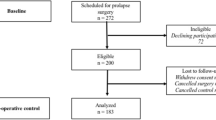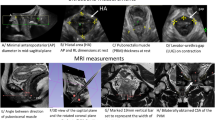Abstract
Introduction and hypothesis
The levator ani muscle is generally thought to play a role in urinary continence, with incontinence assumed to be due to abnormal muscle function or morphology. This study examined whether avulsion of the puborectalis muscle is associated with symptoms or signs of bladder dysfunction.
Methods
In a retrospective observational study, we reviewed the records of 425 women who had attended a urogynecological unit for independent flowmetry, multichannel urodynamic testing, and 4D pelvic floor ultrasound.
Results
Mean age was 55 years (range, 17–87 years). Of 420 women with complete datasets, 104 (25%) were diagnosed with a puborectalis muscle avulsion. These women were less likely to suffer from stress urinary incontinence (SUI; P < 0.001) and urodynamic stress incontinence (USI; P = 0.065) and more likely to present with symptoms of prolapse (P < 0.001) and show signs of voiding dysfunction (P = 0.005). The negative association between avulsion and SUI persisted in multivariate models.
Conclusion
Puborectalis muscle trauma is not associated with an increased risk of SUI or USI in a urogynecological population, even when controlling for symptoms or signs of prolapse and previous surgery.


Similar content being viewed by others
References
Kearney R, Miller J, Ashton-Miller J, Delancey J (2006) Obstetric factors associated with levator ani muscle injury after vaginal birth. Obstet Gynecol 107(1):144–149
Dietz HP, Lanzarone V (2005) Levator trauma after vaginal delivery. Obstet Gynecol 106:707–712
Dietz HP (2007) Quantification of major morphological abnormalities of the levator ani. Ultrasound Obstet Gynecol 29:329–334
Hoyte L, Schierlitz L, Zou K, Flesh G, Fielding JR (2001) Two- and 3-dimensional MRI comparison of levator ani structure, volume, and integrity in women with stress incontinence and prolapse. Am J Obstet Gynecol 185(1):11–19
DeLancey JO (2002) Fascial and muscular abnormalities in women with urethral hypermobility and anterior vaginal wall prolapse. Am J Obstet Gynecol 187(1):93–98
Gainey HL (1943) Post-partum observation of pelvic tissue damage. Am J Obstet Gynecol 46:457–466
Kearney R, Miller JM, Delancey JO (2006) Interrater reliability and physical examination of the pubovisceral portion of the levator ani muscle, validity comparisons using MR imaging. Neurourol Urodyn 25(1):50–54
Dietz HP, Shek KL (2008) Validity and reproducibility of the digital detection of levator trauma. Int Urogynecol J Pelvic Floor Dysfunct 19:1097–1101
Dietz HP, Gillespie A, Phadke P (2007) Avulsion of the pubovisceral muscle associated with large vaginal tear after normal vaginal delivery at term. Aust N Z J Obstet Gynaecol 47:341–344
Lien KC, Mooney B, DeLancey JO, Ashton-Miller JA (2004) Levator ani muscle stretch induced by simulated vaginal birth. Obstet Gynecol 103(1):31–40
DeLancey J, Morgan D, Fenner D, Kearney R, Guire K, Miller J et al (2007) Comparison of levator ani muscle defects and function in women with and without pelvic organ prolapse. Obstet Gynecol 109(2):295–302
Dietz HP, Simpson J (2008) Levator trauma is associated with pelvic organ prolapse. Br J Obstet Gynaecol 115:979–984
DeLancey J (2005) The hidden epidemic of pelvic floor dysfunction: achievable goals for improved prevention and treatment. Am J Obstet Gynecol 192:1488–1495
Dietz HP, Steensma AB (2006) The prevalence of major abnormalities of the levator ani in urogynaecological patients. Br J Obstet Gynaecol 113(2):225–230
Dietz HP (2004) Ultrasound imaging of the pelvic floor: 3D aspects. Ultrasound Obstet Gynecol 23(6):615–625
Bump RC, Mattiasson A, Bo K, Brubaker LP, DeLancey JO, Klarskov P et al (1996) The standardization of terminology of female pelvic organ prolapse and pelvic floor dysfunction. Am J Obstet Gynecol 175(1):10–17
Abrams P, Cardozo L, Fall M, Griffiths D, Rosier P, Ulmsten U, van Kerrebroeck P, Victor A, Wein A (2002) The standardisation of terminology of lower urinary tract function: report from the Standardisation Sub-committee of the International Continence Society. Neurourol Urodyn 21(2):167–178
Dietz HP, Shek K, Clarke B (2005) Biometry of the pubovisceral muscle and levator hiatus by three-dimensional pelvic floor ultrasound. Ultrasound Obstet Gynecol 25:580–585
Dietz HP (2009) Tomographic ultrasound of the pelvic floor: which levels matter most? Ultrasound Obstet Gynecol (in press)
Weinstein MM, Pretorius D, Nager CW, Mittal R (2007) Inter-rater reliability of pelvic floor muscle imaging abnormalities with 3D ultrasound. Ultrasound Obstet Gynecol 30(4):538
Laycock J (1994) Clinical evaluation of the pelvic floor. In: Schuessler B (ed) Pelvic floor re-education: principles and practice. Springer, London, pp 42–48
Mant J, Painter R, Vessey M (1997) Epidemiology of genital prolapse: observations from the Oxford Family Planning Association Study. Br J Obstet Gynaecol 104(5):579–585
Rortveit G, Daltveit AK, Hannestad YS, Hunskaar S (2003) Urinary incontinence after vaginal delivery or cesarean section. N Engl J Med 348(10):900–907
Otcenasek M, Krofta L, Baca V, Grill R, Kucera E, Herman H et al (2007) Bilateral avulsion of the puborectal muscle: magnetic resonance imaging-based three-dimensional reconstruction and comparison with a model of a healthy nulliparous woman. Ultrasound Obstet Gynecol 29:692–696
Dietz HP, Shek C (2008) Levator avulsion and grading of pelvic floor muscle strength. Int Urogynecol J Pelvic Floor Dysfunct 19:633–636
Abdool Z, Shek KL, Dietz HP (2009) The effect of levator avulsion on hiatal dimension and function. Am J Obstet Gynecol (in press)
Dietz HP, Haylen BT, Vancaillie TG (2002) Female pelvic organ prolapse and voiding function. Int Urogynecol J 13(5):284–288
Wilson PD, Hay Smith EJ, Nygaard IE, Wyman JF, Yamanishi T, Berghmans B et al (2005) Adult conservative management. In: Abrams P, Cardozo L, Khoury S, Wein A (eds) Incontinence: third international consultation on incontinence. Health Publications Ltd, Paris, pp p855–p964
Snooks SJ, Swash M, Mathers SE, Henry MM (1990) Effect of vaginal delivery on the pelvic floor: a 5-year follow-up. Br J Surg 77(12):1358–1360
Allen RE, Hosker GL, Smith AR, Warrell DW (1990) Pelvic floor damage and childbirth: a neurophysiological study. Br J Obstet Gynaecol 97(9):770–779
DeLancey JO (2001) Anatomy. In: Cardozo L, Staskin D (eds) Textbook of female urology and urogynaecology. Isis Medical Media, London, UK, pp 112–124
Conflicts of interest
Prof. H.P. Dietz has received honoraria as a speaker from GE, Astellas and AMS and has acted as consultant for CCS and AMS. He has also received equipment loans from GE, Toshiba, and Bruel & Kjaer.
Author information
Authors and Affiliations
Corresponding author
Rights and permissions
About this article
Cite this article
Dietz, H.P., Kirby, A., Shek, K.L. et al. Does avulsion of the puborectalis muscle affect bladder function?. Int Urogynecol J 20, 967–972 (2009). https://doi.org/10.1007/s00192-009-0882-1
Received:
Accepted:
Published:
Issue Date:
DOI: https://doi.org/10.1007/s00192-009-0882-1




